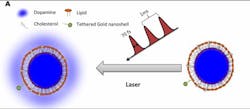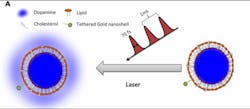Femtosecond laser enables targeted drug delivery for Parkinson's
The Okinawa Institute of Science and Technology (OIST) Graduate University’s Femtosecond Spectroscopy Unit and Neurobiology Research Unit (both in Okinawa, Japan), along with collaborators at the University of Otago (Dunedin, New Zealand), are using femtosecond lasers, nanotechnology, and neuroscience to develop a new, versatile drug delivery system. The researchers' work involves using a laser to release a neurochemical that is dysfunctional in Parkinson’s disease in a controlled and repeatable manner.
Related: Light-activated chemotherapy delivery limits side effects
Recent advances in nanotechnology and biology are opening up the possibilities in targeted drug delivery, where researchers can release drugs or compounds in a specific tissue or even individual cells, which would allow the drug to reach only its intended target. The OIST researchers developed a method to encapsulate a drug in a shell of lipids, or fat, called a liposome, and modulate the release of the drug using a pulse from a femtosecond laser.
Members of the Neurobiology Research Unit approached the Femtosecond Spectroscopy Unit with the idea to apply laser technology in a possible therapy for Parkinson’s disease, in which the neurochemical dopamine does not function properly. The researchers wanted to use the precise timing and intensity of femtosecond lasers to control the release of dopamine in a way that mimicked its natural dynamic mechanism, so they encapsulated dopamine in a liposome tethered to a gold nanoparticle. They used a femtosecond laser pulse as the energy source. The energy is absorbed by the gold nanoparticle and then transferred to the liposome, causing the liposome to open and release the dopamine. The length of time and therefore amount of dopamine released can be precisely controlled by the intensity and length of time the laser is on. The researchers also showed that the liposomes are not destroyed by the laser as in previous similar studies; therefore, the release of dopamine—or any chemical contained within the liposome—can be repeated and controlled.
"With this method, we can administer a wide range of drugs with precise timing and duration using laser pulses with sub-second accuracy. We are very excited about the potential this new tool brings to neurobiological research," says Takashi Nakano, OIST Neurobiology Research Unit.
The next step is using these laser-activated liposomes in living tissue and, eventually, in a live animal. The ability to release potentially any type of drug, chemical, or naturally occurring compound in the right place at the right time with a controlled dosage will open new possibilities in medicine.
Full details of the work appear in the journal Scientific Reports; for more information, please visit http://dx.doi.org/10.1038/srep05398.
-----
Don't miss Strategies in Biophotonics, a conference and exhibition dedicated to development and commercialization of bio-optics and biophotonics technologies!
Follow us on Twitter, 'like' us on Facebook, and join our group on LinkedIn
Subscribe now to BioOptics World magazine; it's free!

